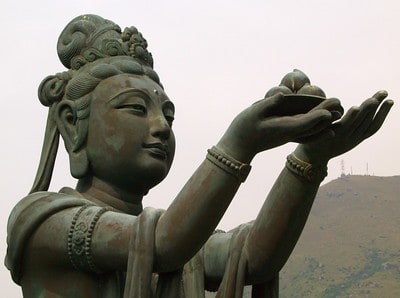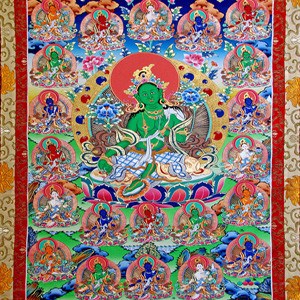Kuan Yin and compassion
In a Bodhisattva's Breakfast Corner talk, Venerable Chodron discusses how to become like Kuan Yin by developing our compassion.
I wanted to thank all of you for the beautiful Kuan Yin statue. She’s now located in her mandala, underneath the willow tree. And I think it would be very nice if we went out there and did a blessing, invoking all the Buddhas and Bodhisattvas in there.
Kuan Yin is the Chinese equivalent of Chenrezig, the Buddha of compassion. There is so much misunderstanding about compassion. Sometimes people think that if they’re compassionate it means that they just back down, that they’re weak. They think compassion is kind of like that. And that’s not what compassion means. Compassion means that we want ourselves and others to be free of suffering and its causes. It’s that wish for both our self and others to be free of suffering and its causes.
The behavior that you use to express that wish can be of many different kinds. Sometimes the behavior is cutting people some slack and helping them out and caring for them and so on. Sometimes having compassion is being very firm and assertive.
We really have to always discriminate these two: what is going on in the mind and what is the behavior? Because we get them confused. Somebody can be very outwardly doing many things for other people, and we may say they’re very compassionate, but maybe their motivation is just because they want other people to like them. It’s not because they want people to be relieved of suffering, but because they don’t want to have the suffering of other people not liking them. We may call that compassion, but it’s not actually.
Similarly, you might have somebody acting in a very direct, straightforward way because that’s what’s needed and that’s what’s beneficial. They have the motivation of compassion, but somebody could look on it and say, “Oh, this person is so aggressive,” or whatever. We always have to look and separate out the motivation and the action. That’s what Kuan Yin is about and is asking us to do.
It’s important not only to be clear in our motivation concerning our own actions, but also in terms of how we respond to other people’s actions. It’s important that we don’t assume we know what their motivation is because like I said, somebody may be kind out of compassion while another person may be kind out of fear.
Somebody can be assertive out of compassion, or somebody can be assertive because they’re self-centered. We don’t really know. We often tend to mindread, don’t we? It’s always good when in doubt to observe more and to check up with the other person. But the core thing in any of this is to check up what’s going on inside us because even if another person doesn’t have a good motivation, why should that disturb our own internal peace?
This is what I do with myself when I get upset. My first reaction is, “Well they did da, da, da, da, da.” And then I say to myself, “Well, that’s true; they did. But why are you angry? Well, they did da, da, da, da, da. Well, yes—but why are you angry?”
So, it’s important to always look at what our reaction is. And then, of course, it’s also important to try to become like Kuan Yin, which is why we do the visualization, why we recite the mantra. Those things help us to get a feeling like we can be like Kuan Yin.
Somebody wrote me recently who is just getting into tantra. He said when he practices now that he feels like he’s a Buddha-to-be who’s practicing instead of a lousy person who’s practicing. And this is the difference between when you visualize the deity and say the mantra and when you do the self-generation—you begin to feel like you’re a Buddha-to-be, and then it becomes easier to become like Kuan Yin.
Venerable Thubten Chodron
Venerable Chodron emphasizes the practical application of Buddha’s teachings in our daily lives and is especially skilled at explaining them in ways easily understood and practiced by Westerners. She is well known for her warm, humorous, and lucid teachings. She was ordained as a Buddhist nun in 1977 by Kyabje Ling Rinpoche in Dharamsala, India, and in 1986 she received bhikshuni (full) ordination in Taiwan. Read her full bio.


